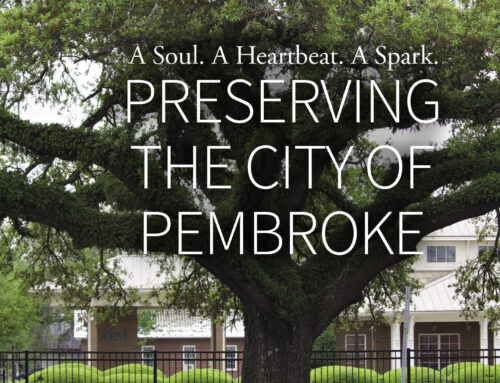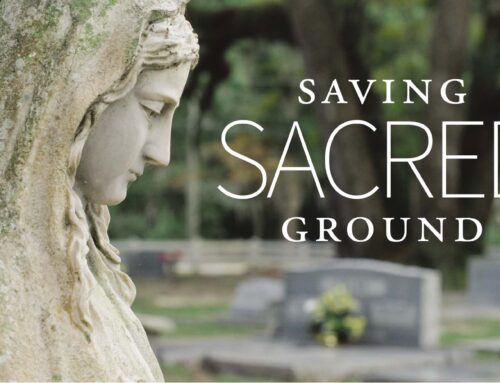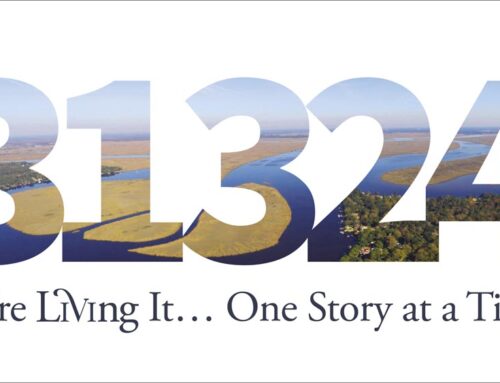
A Hard Day’s Work
WORDS BY PAIGE GLAZER
2023 ANNUAL ISSUE
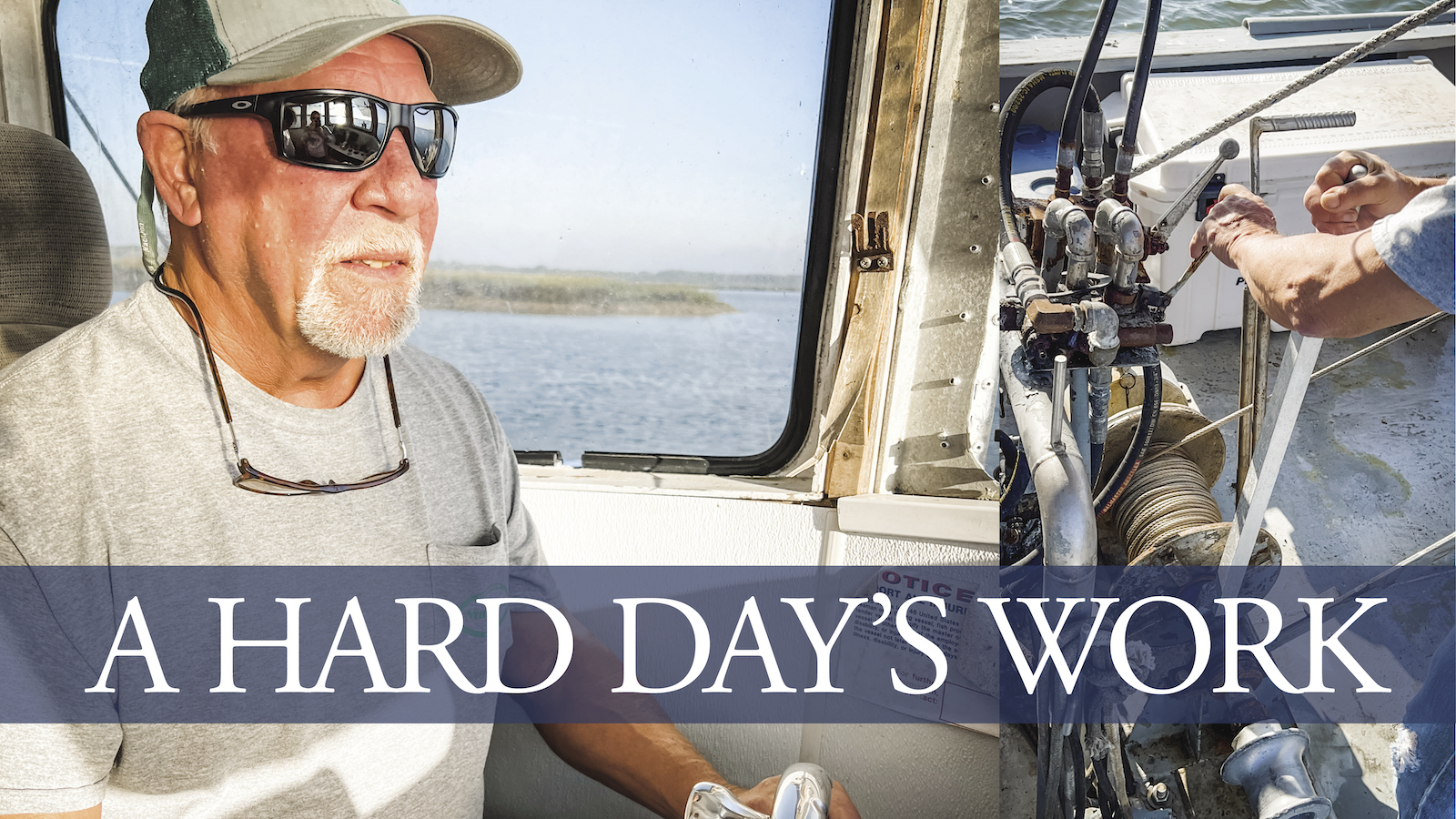
There is nothing like a conversation with a fisherman—from the youngest of them to those who are getting up there in age. Their stories are often the kind you can only imagine, because you’ve never personally seen what it is they are talking about, and they know you might not ever, so they aren’t opposed to a little bluffing to embellish it for you. They are souls of a different type, and I haven’t met one yet that I wouldn’t call salt of the earth.
The sun was shining bright last Tuesday morning when we left Lincoln River on a shrimp boat. We caught at least a dozen different kinds of fish in our three drags, and a boatload of fresh Georgia shrimp! It was a secret spot only the saltiest know, where the big boats can’t go.
I’ve ridden all over our waterways since I was a young girl, but never in a shrimp boat. I’ve written stories about the demise of the shrimping industry, the history of legendary shrimp boats, boat names and renames, crazy catches, the history of the Bryan Fisherman’s Co-Op, and the future of it, but had never actually experienced it for myself until last Tuesday! I might be embellishing a little here because I can, now that I have my own story to tell.
The engine hummed a really deep sound as we picked up speed in the sound. She was hammer down at six knots as we rounded the south side of Ossabaw Island, one of the most picturesque scenes in all of Coastal Georgia (in my opinion). Between two barrier islands, we all admired both their beautiful white sandy beaches and salty skeletons that once were lively trees lining the tidelines. Just as the river met the ocean, we steered her port side and headed north on the east side of Ossabaw Island towards the slough. We left the dock early and we had nothing else on the agenda for the day, except trying our luck. In state waters (less than three miles offshore), you are allowed to drag nets 30 minutes before sunrise until 30 minutes after sunset, so time was on our side.
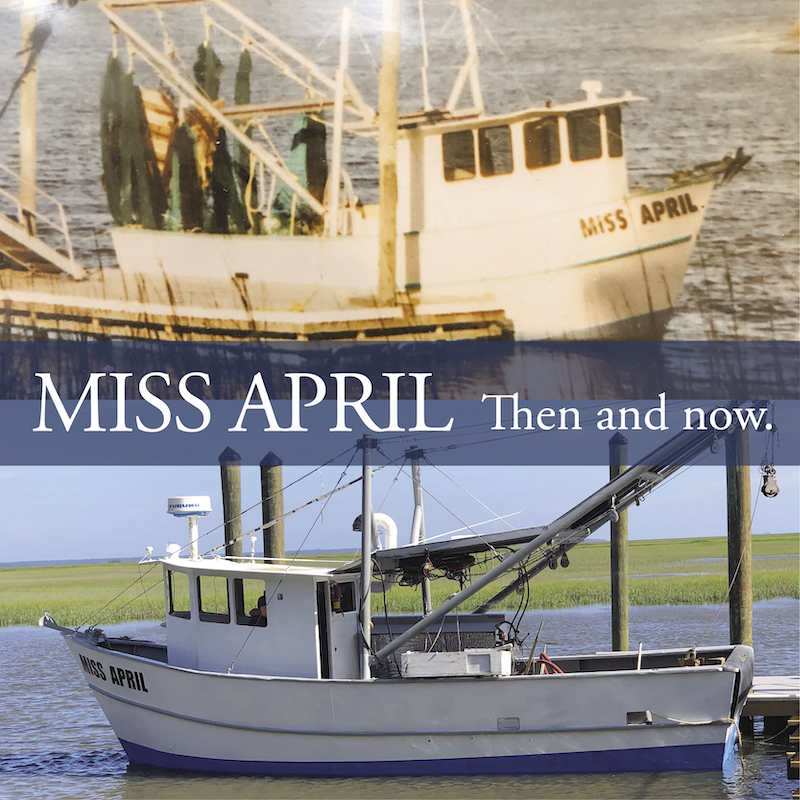
You know… it’s a funny thing when you are going somewhere you have never been with someone you have never met navigating the channels, but you never once question your well-being or that you will get where you are going (and back), you just know you are in good hands. Some might have panicked when the depth finder flashed 2.2 feet, but not me. It was like watching someone thread a needle. I was standing beside the captain’s chair, just chatting about what “Miss April” was made of when he said, “No worries, she only draws about a foot and a half, we’re still ok.” I’m assuming my face must have had a look of concern because I didn’t ask, although I was beginning to wonder how skinny we could get before running aground. The tide wasn’t quite low yet, so any quick drop of seven inches would make for a really long day.
Steve Sawyer was captain that day, and I’d say he knows every nook and cranny of the 30’ Trawler we were in better than anyone out there since he built the boat. I did not know this going into the day, but like I said about conversations with fisherman—there’s nothing like them.
“I’ve been fascinated with boats since I was a little boy,” Steve said in response to my question, that wasn’t so much a question as it was an exclamation, ‘What? You built this boat?!’”
I was just happy to be invited on a shrimp boat, I didn’t know I’d gain the perspective and learn the craft from the boat builder, too. If I am being honest, when I think (or thought) about boat building, I pictured it happening in some distant factory with an assembly line and a slew of worker’s adding a piece at a time, and rolling her out in a shipyard maybe somewhere near a deep river. Not a guy and his buddy, in a nearby machine shop, working til the wee hours after work each day for six months until she was complete (1995).
“I fished her for two years and then sold her, and about five years ago, a guy called me out of the blue and told me he had the boat I built. He asked if I wanted to buy it. I told him yes, and here we are,” Steve continues the history. “There are some things that aren’t original, like the captain’s chairs; she was so pretty when I had her.”
“The deal was, if Steve came to work for us,” MacAljon’s founder, Ben MacMillan, chimed in, “he’d have the right to build this boat in our shop. Steve is one of the most talented metal fabricators out there. He and Gary Hill would go down to the shop every afternoon and work on it. It didn’t take them long,” he added. “They built the boat on a mobile home trailer that John Usher gave them.”
“The boat is made of aluminum. And all the rigging is stainless so it won’t rust,” Steve said. As I looked around, I noted the creative components used used for winch handles and hand brakes, and the dock cleats for fastenings to hold all the cables and doors, chains, and nets. It was pretty clear that Steve had talent—he is described as one of those guys who can literally build anything they imagine. Steve had to go assist moving an electrical wire to the winch from the water pump, so I took over at the helm for a minute—awesome! I went shrimping and drove a shrimp boat in the same day. I guess we can add electrician to his Steve’s list of know how’s as well, I thought as I inhaled a big breath of salt air.
Steve told me more about Miss April as he threaded that needle into “Ossabaw East.” She is named after his daughter. Her maiden voyage was out of Fort McAllister. At this point in his life, no one would be able to afford the shrimp he catches, so mostly it’s just a few good buddies, a tank of diesel—currently worth the price of gold, and a day of fishing when he takes her out. They do it as often as they can during the season, always in state waters, never venturing too far. He has built several racing boats, trucks, and buildings you’d know if you saw, and assisted heavily in the restoration of The Real Deel (we shared the story about that boat in a recent issue).
When we reached Steve’s honey hole, I watched as the guys dropped the 45-foot net and doors down to begin the day’s catch. Every step a lesson for me and the realization of the extreme knowledge needed for performing them. Steve told me she was built for two nets, but “without “real” deckhands, one keeps things simple.” We fished the bottom, and Miss April felt and sounded like a locomotive as she inched along slowly. It was relatively calm, but the boat was still rocking pretty good, we could see the shore so the waves didn’t bother anyone. Every 30 minutes, we pulled the nets in and emptied our bounty into red and blue buckets before pouring them over the table built for heading (or napping if you are Noah Holly and Mr. Ben). We caught about a hundred pounds in an hour and a half. We hustled in between drags to head them and bag them. We threw back flounder, sand dollars, sharks, squid, crab and some of the coolest, yet most odd-looking little bait fish I’ve ever seen. You might be wondering how much shrimp we each got to take home that day. Let’s just leave it at plenty!
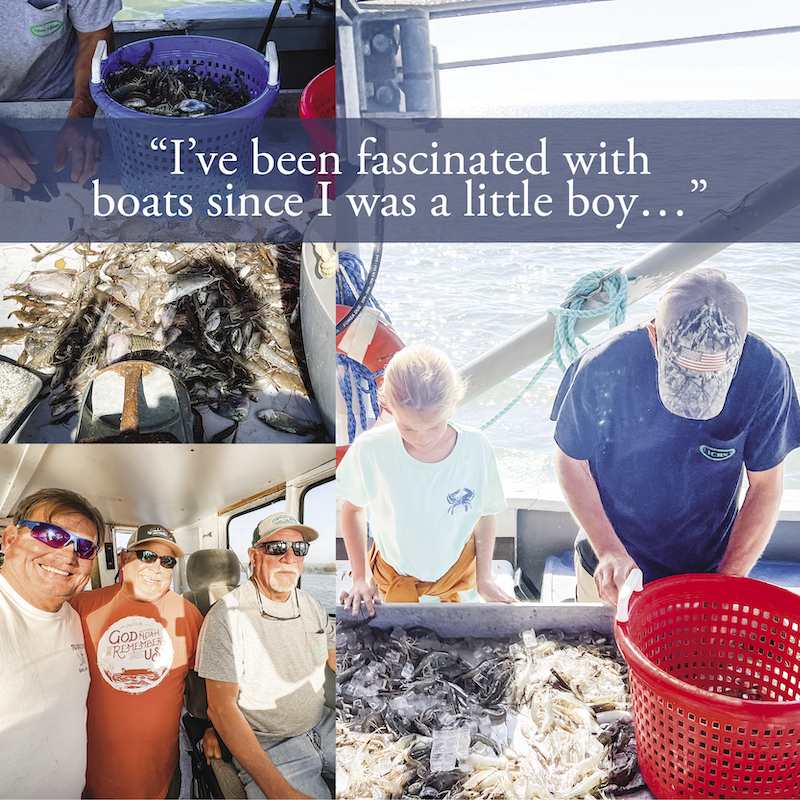
Until now, I did not know what story I would end up writing about the day I got to be a shrimper with more than a cast net. My journal is full of notes I took about the sights, sounds, the company we kept and the conversations we had. There were three of us who had never been shrimping, we didn’t add much value to the team that day except when it came to heading them. I remember thinking about all that goes into eating a meal that includes shrimp that we take for granted. Everyone thinks about the farmer, do they think about the fisherman out there, too? Do they think about who built the boat and all of the knowledge needed to navigate the open waters, the knots you need to tie, how the nets work, what happens when a wire needs work on the water pump or the winch while you are out at sea? You can’t pull your nets in without a winch.
This reminded me of a story we shared 11 years ago about a local shrimp boat captain, Leonard Crosby. Leonard was one of the original Bryan Fisherman’s Co-Op owners when they built it in 1979. He tells the best stories about the height of the industry when there were 1,500 licensed commercial shrimpers in Georgia. We only saw two shrimp boats while out on the water that day. The day I went shrimping on a shrimp boat with a boat builder was truly just for fun, but the actual take away was so much more than a quart of shrimp. I have a new overwhelming feeling of appreciation for the fisherman—he has to know a little bit about a whole lot!
So next time you pull the tail from a fried shrimp while dining at Fish Tales or Marker 107, remember the fisherman (and boat builder), and say a prayer for the future of the industry to continue to persevere the obstacles that have challenged them for decades, and for the salty captains to keep enjoying the thrill of the catch—it’s a hard day’s work— no embellishing necessary.
Mr. Ben, I’m still waiting on that shrimp salad sandwich.

